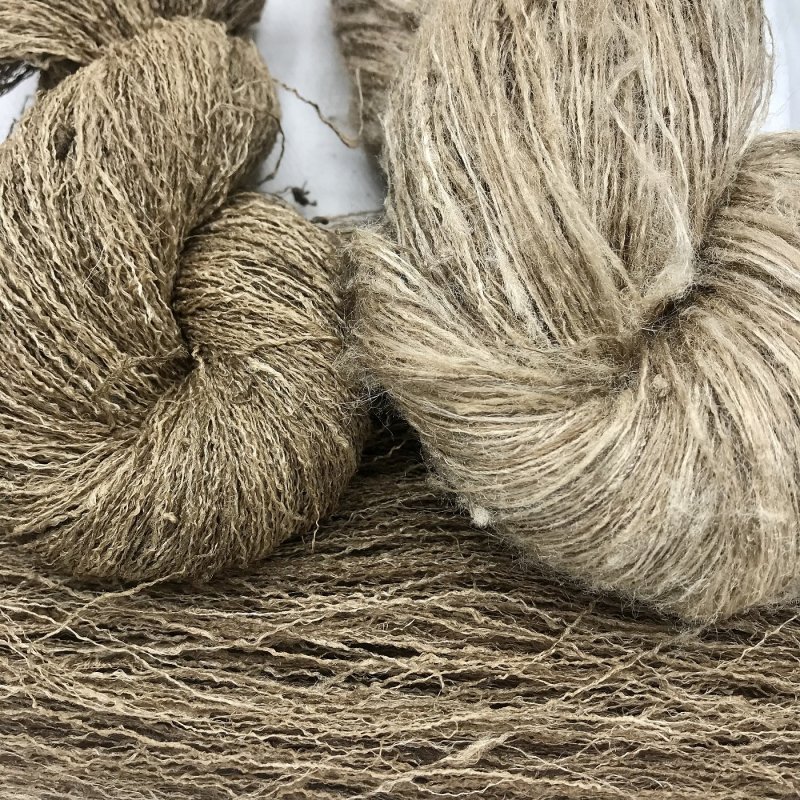
Photo: Wild Tasar Silk Ghicha yarn, "pot" reeled/pulled in India by the Dewangan tribal women.
We are excited to introduce Wild Tasar Silk Ghicha yarn from India. This is a very skinny yarn hand-crafted by women from the Dewangan tribe. To order this special silk, CLICK HERE.
HOW GHICHA YARN IS MADE
Ghicha yarn is often thigh reeled (read more about this in Karen Selk’s “In Search of Wild Silk” book beginning on page 110). The women of Dewangan tribe use the outer side of the bottom of a round cooking pot. [see photo #2 in gallery below].
Wild Tasar Silk Ghicha yarn is often called reeled silk. However, this method of reeling is different than how bombyx, mori and Muga silk cocoons are reeled.
Wild tasar silk cocoons are “hard”. You can’t run your fingernail across the outside of the cocoon and snag a silk filament, like you do with other types of silk cocoons.
The wild tasar silk cocoons are cut and boiled. In the photo, you can see the prepared cocoons in the green bin (right side).
The silk from 6 to 8 cocoons are “pulled” to release a single strand. The strands are rolled across the pot’s smooth surface to add a little twist to the silk. If you endarge the photos of the silk yarn, you can see the twist.
“Ghicha” is the Hindi word for “pulled” and that is why silk created using this process is called Ghicha yarn.
ABOUT THE SILK SKEINS
This yarn is very thin…it’s about the same size as 60/2 bombyx silk [see photo in gallery below].
The skeins are VERY stiff. So stiff I can’t twist them into skeins (they’ll arrive “folded”). [see photo in gallery below]
Hammering
Hansraj, my silk guy, said that the tribal weavers beat it with a small wooden hammer before weaving with it. This will soften some of the sericin “then it’s ready to good weaving”.
No wooden hammer so I improved. I laid out a few layers of old soft cotton (maybe a cloth diaper in a former life?) on our concrete patio. Then I covered a 3-lb flat stone in more soft cloth and began “hammering” the Wild Tasar Silk Ghicha yarn.
I spent less than 5 minutes and there’s an amazing difference! I can now twist the “hammered” yarn into skein. It is “flexible” but I wouldn’t describe it as “soft” at this point. [see photo in gallery below]
In addition to adding flexibility to the silk skein, the hammering released many flecks of “non-silk” foreign matter.
Finding the ends in the skein
As with other tribal made silk yarns, the ends can take a bit of patience to identify. If I don’t find them quickly while “popping” the skein between my hands, then I put the skein on a swift (horizontal, of course), and then run my hands over the surface of the skein, to find the loose ends.
WASHING
BEFORE I talked with Hansraj, I tried washing a skein of Wild Tasar Silk Ghicha yarn in hot tap water with a bit of syntrapol soap, to see if that would soften then yarn. It did, but..keep reading learn the challenges of washing BEFORE using this silk.
Side note: whenever I wash any silk skein, I never “jostle” it in the basin of water. I hold the skein between the “O” made with thumb and index finger, and repeatedly lift the silk up and down, in and out of the water. I learned this up/down washing method from Anne, one of our retired dyers. This method allows the water to run down the silk skein, letting water + gravity combination to “smooth” the skein, which creates a “happier” skein.
The water immediately became VERY brown. I probably only washed it for a minute or two, then switched to rinse water. After 4 basins of rinsing, the water was just cloudy, and I called that "good enough" since I knew the silk would be wet finished (washed again) after it was woven.
I used our spin-dryer to remove excess moisture (you can roll it in a thick towel…use an old one as it might leave golden brown color on the towel).
I gently popped the skein and spread the strands of silk. I repeated this a few times during the drying process.
What I learned about washing
Dumb thing #1: I didn’t find and secure the ends with a white skein tie before washing. I created work for myself as the ends were harder to find after the skein was washed.
Dumb thing #2: I didn’t replace the delicate skein ties with something a bit sturdier. One of the ties broke (luckily just one!), even though I was fairly gentle handling the silk through the washing and drying process.
Since there is very little twist to Ghicha silk, it "blooms" (aka “fuzzes”), causing adjacent strands to grab onto one another. Because I spread the skein (to separate the strands) while it was drying, it’s not as "sticky" as it might have been otherwise.
However, It will take a bit of patience to transfer the silk from the skein to a weaving bobbin—I suggest hand-winding (not electric winding) so you can be sensitive to the yarn and its characteristics.
By washing it, the silk became softer. The silk also lost some of the brown color and became more golden—a lovely color! You can see the difference between the washed and unwashed in the lead photo above.
RECOMMENDATIONS
1) follow Hansraj’s advice and hammer the skein before using.
2) wait to wash until AFTER you’ve woven with it. But be prepared for dirty water.





